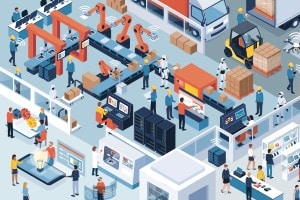Human Machine Interface (HMI): The basis for human-machine interaction
The high level of technological innovation that has characterized the last three decades is changing everyone’s life. In the private sphere, this is primarily due to the advent of digital end devices and constant networking – in business through intelligent machines and systems (Industry 4.0), artificial intelligence (AI) and continuous advances in materials and supplies. However, one component remains: the human being as an active player in this situation.
Our logistics lexicon provides you with insights into the basics of Human Machine Interfaces (HMI) as a user interface for practically any machine, regardless of age.
Definition of Human Machine Interface: What is behind the term?
Machines and systems are only ever as efficient and integrative as the person operating them (e.g. the operator) is able to control the whole. All aspects that characterize the term “Human Machine Interface” relate to the interface between man and machine.
An example from everyday life: a car can be used completely, at least to a large extent, without the driver having to use any relevant muscle power. However, the main control elements – the accelerator pedal, clutch, brake and steering wheel – are essential for steering the vehicle. Each of these components is a Human Machine Interface (HMI) in its own right.
In the context of logistics processes, these are naturally different aspects, but the principle remains the same. Industrial PCs are a classic human-machine interface in the industrial or commercial sector. They enable system control even under adverse conditions, are insensitive to cold, heat or vibrations and are used for process visualization or in the field of production technology.
Where are Human Machine Interfaces used? Typical areas of application
Even if the term suggests otherwise, Human Machine Interfaces (HMI) have been with us since the beginning of time, when the first machines or tools were developed. To stick with a simple example: the light switch is the link between the person (user) and the electrical control system to switch the light on and off.
We would like to show you further examples of an HMI:
- The steering wheel as the HMI of vehicles such as cars, trucks, industrial trucks (pallet trucks, forklifts, etc.) and co.
- The switch as an HMI for operating certain systems (light control, roller shutter drive, etc.)
- The computer as an HMI for controlling programs
- The industrial PC as an HMI for the functional control of machines, systems and storage areas
Advantages of an HMI and other relevant aspects of a user interface
Despite all the technical possibilities, people continue to take the lead in most segments. A human-machine interface is the link between people and machines, offers opportunities to exert influence and makes efficient warehouse management possible in the first place. The use of HMIs such as the industrial PC is particularly important when it comes to making warehouse management as efficient as possible. This computer, also known as an IPC, is designed for use in the industrial sector and offers the necessary interfaces and construction types required for intuitive use.
Advantages of using a Human Machine Interface (HMI):
- Simple and intuitive function control using buttons, levers and other components
- Simple visualization of processes to optimize control
- Influencing processes that are (partially) automated
- Reduction of complexity in the handling of machines, systems and co.
- Display of all relevant performance data on a central tool
- Increased productivity and simplified adjustments through the use of a Human Machine Interface (HMI)
- Easy integration into existing systems (e.g. warehouse) thanks to communication protocols and interface compatibility
Important: The characteristic feature of a Human Machine Interface (HMI) is often a simplification that gives the user clear options for carrying out precisely defined actions. E.g., an industrial PC has a touchscreen display which makes it easier to use – icons are used to control the most important functions at the click of a button. Nevertheless, there is still a command line interface in the background that allows developers to customize the system. The Human Machine Interface is supposed to reduce complexity, but to provide the necessary security and enable effective control as well.
